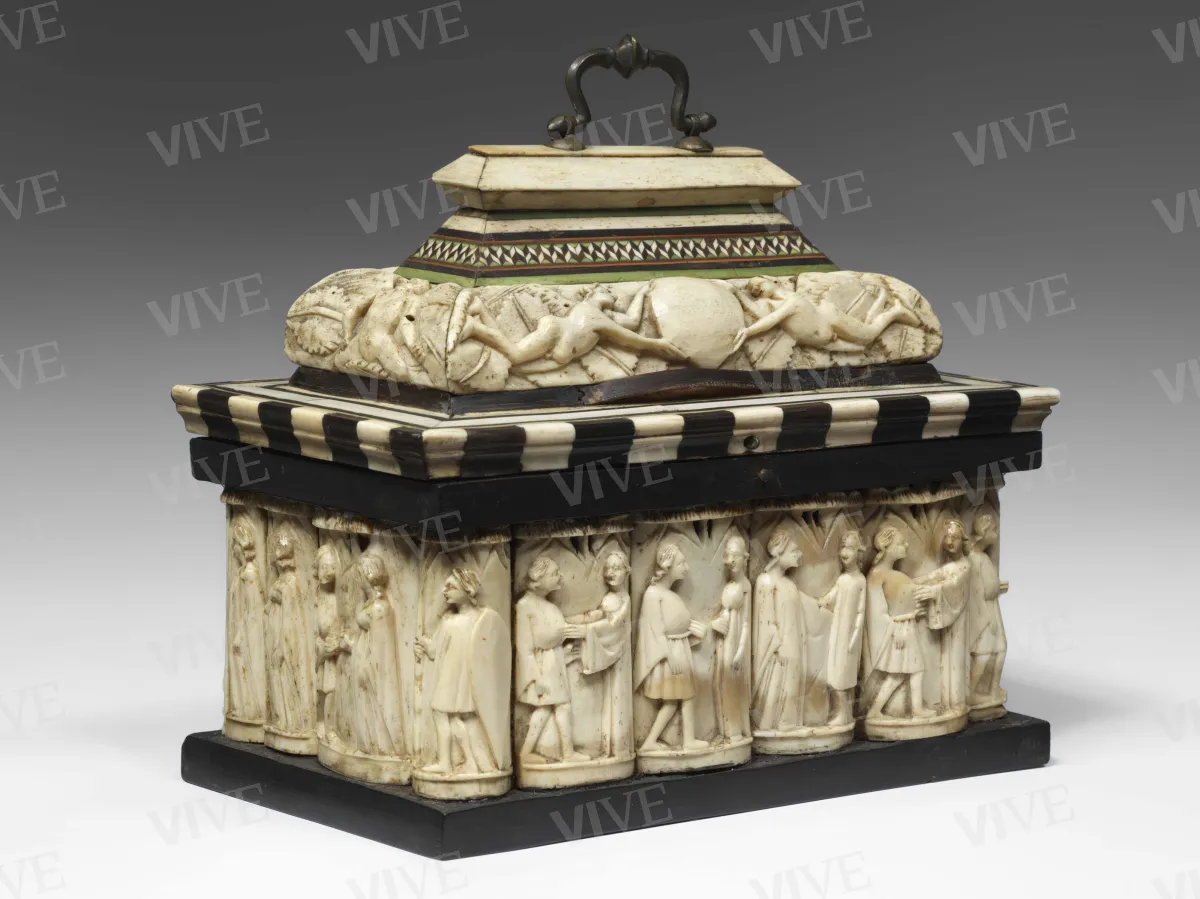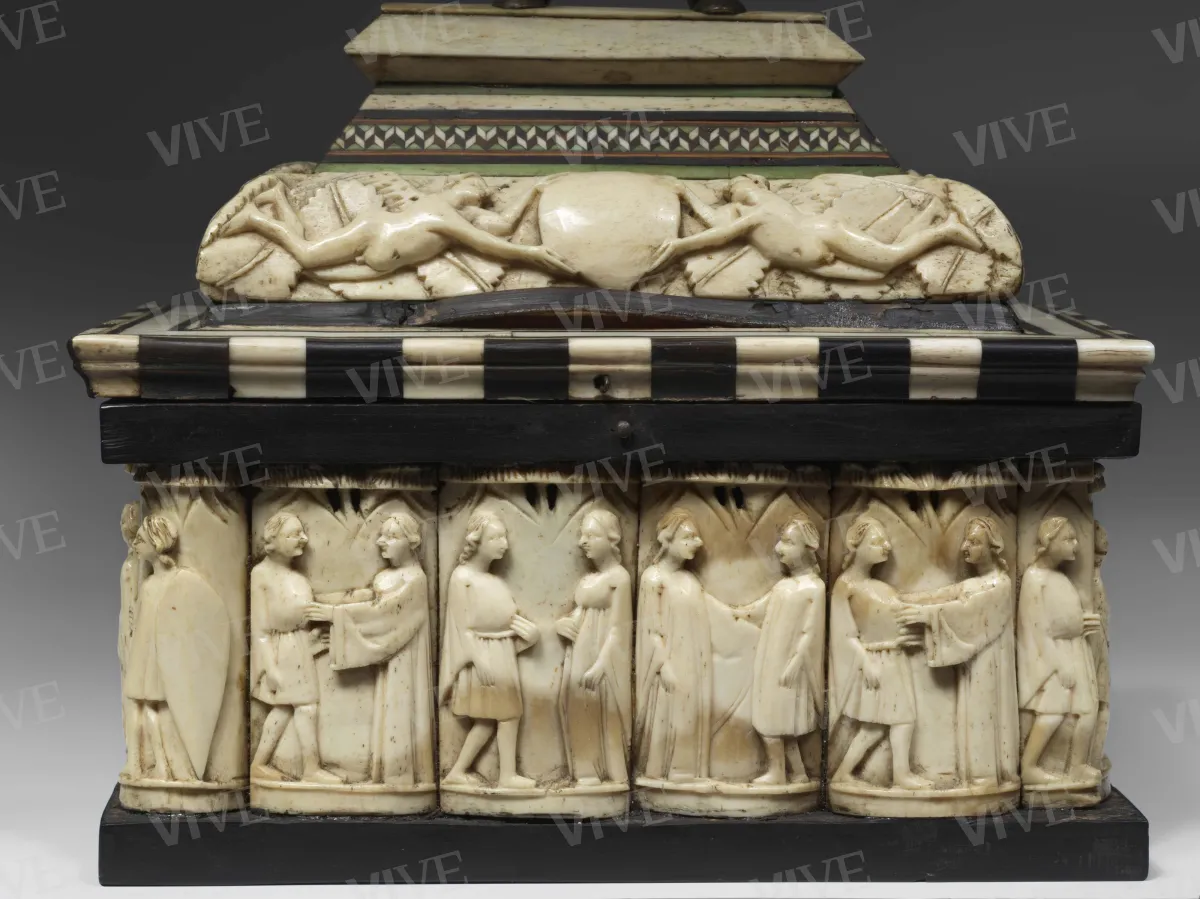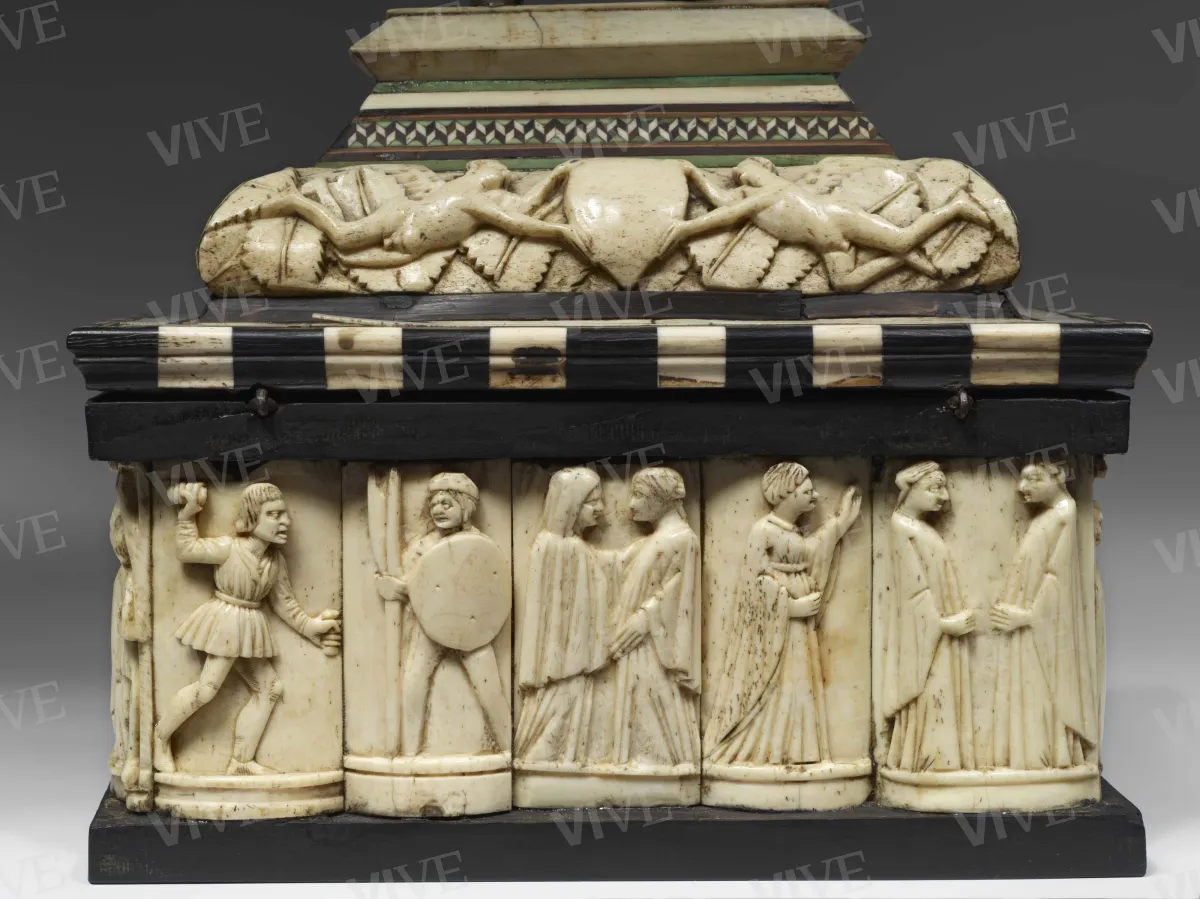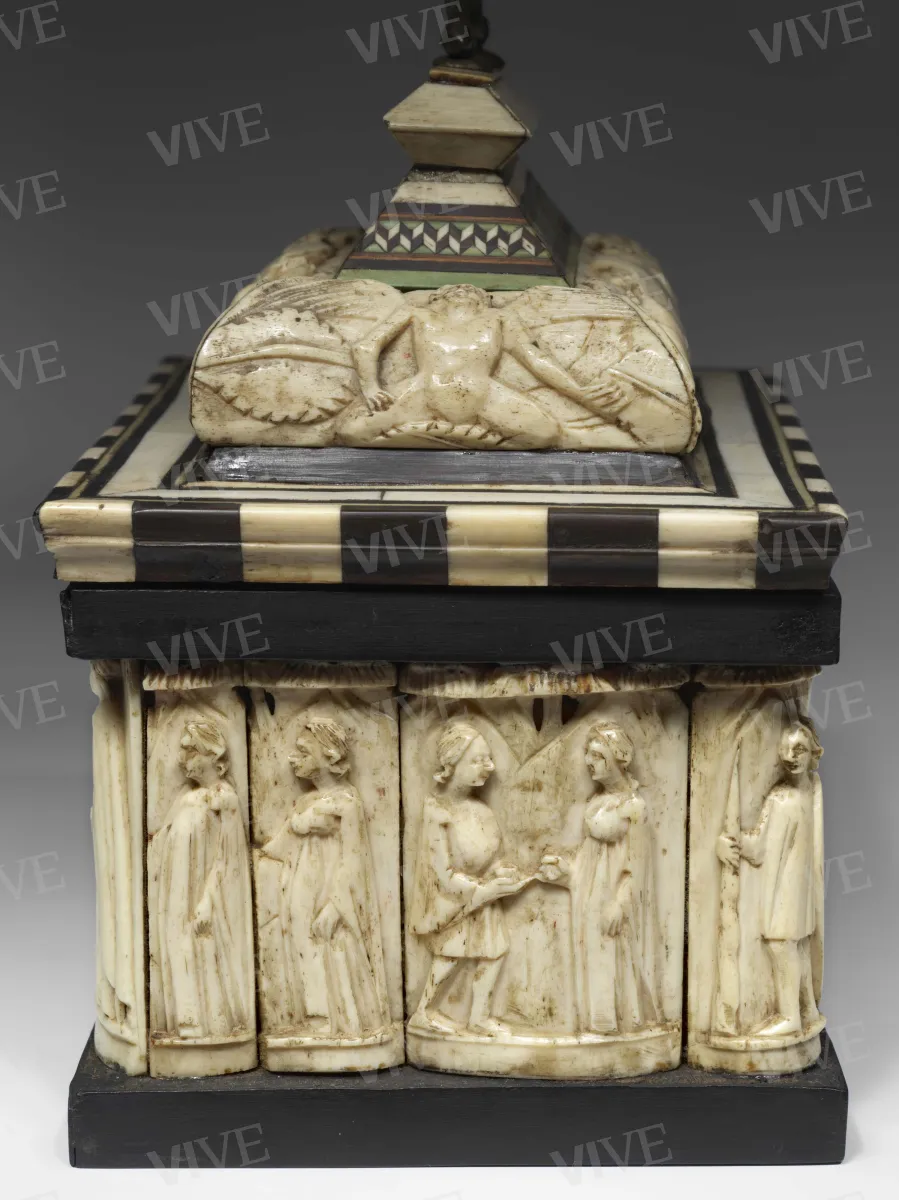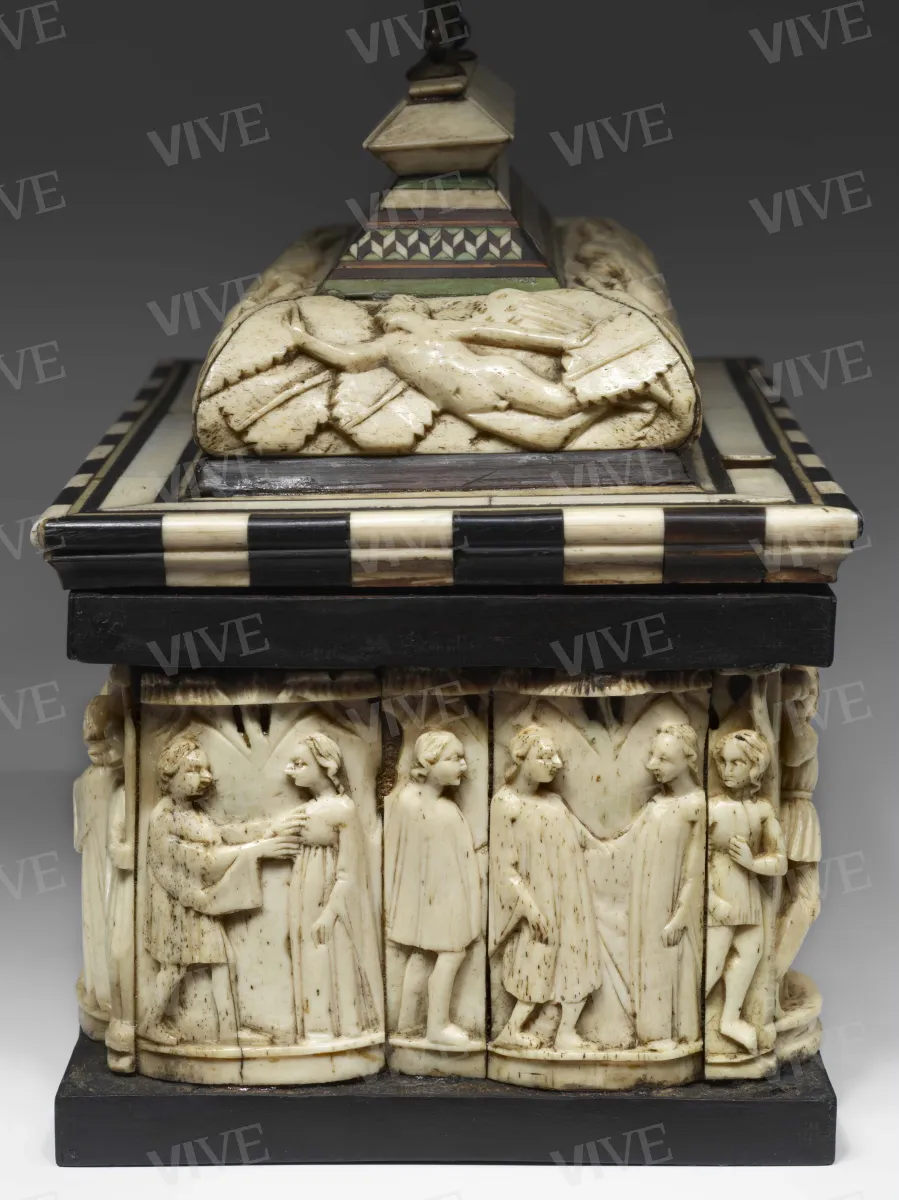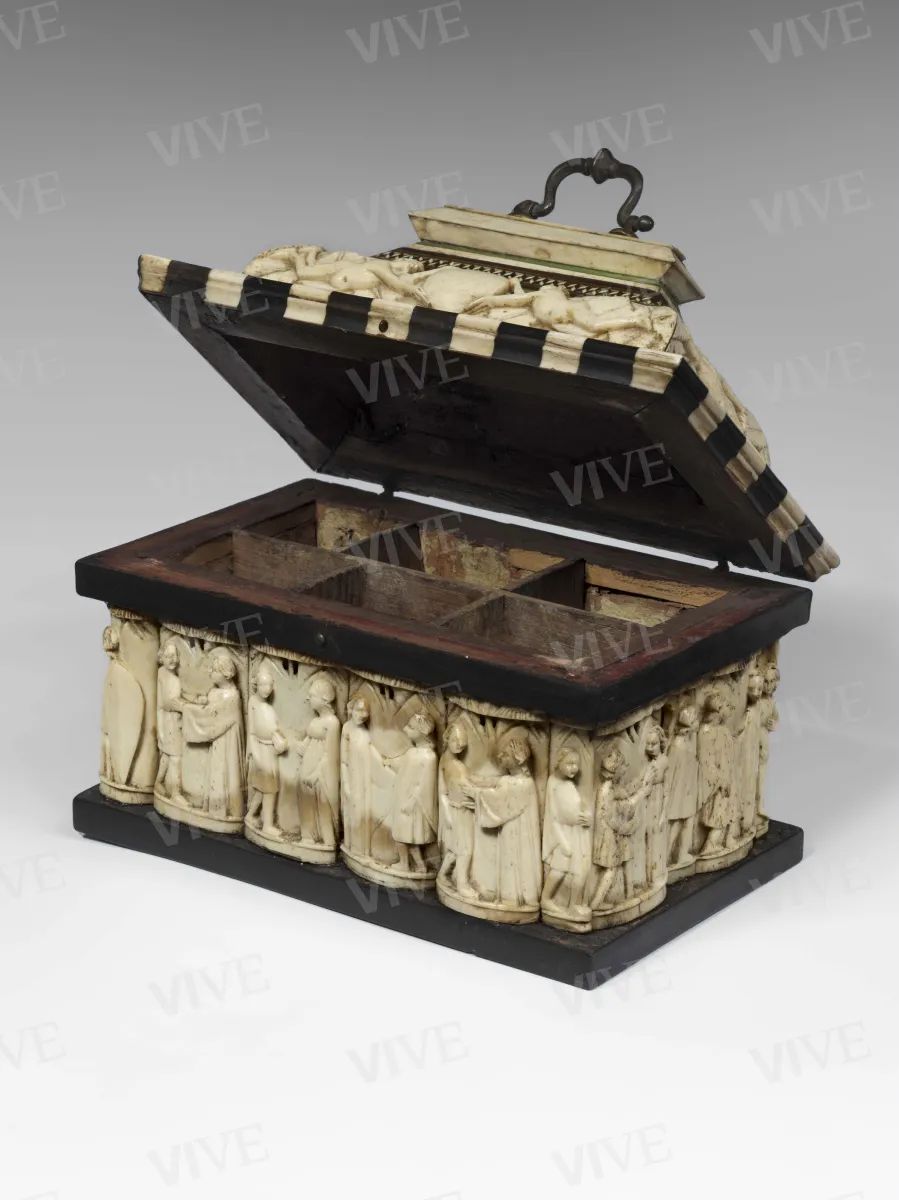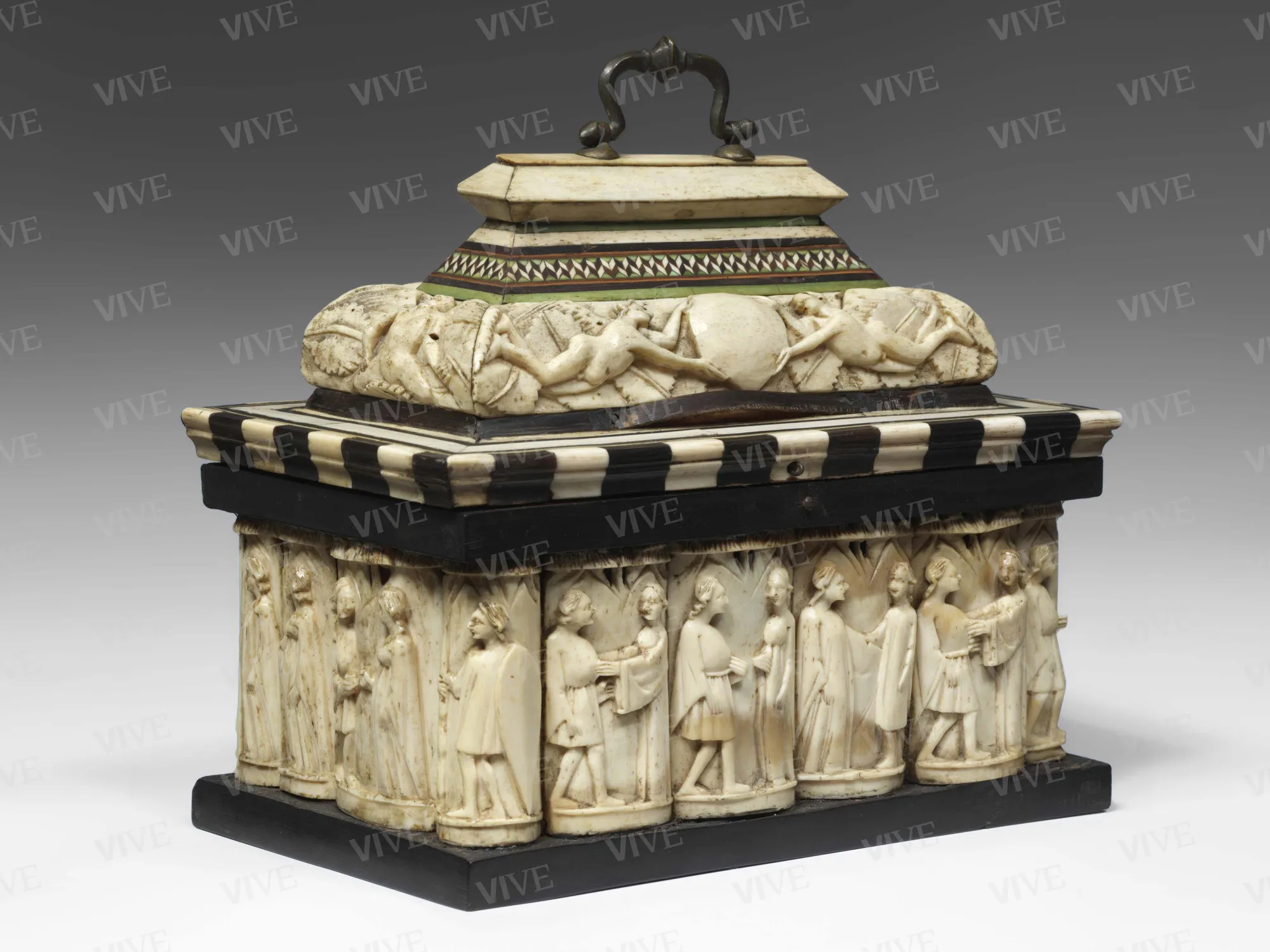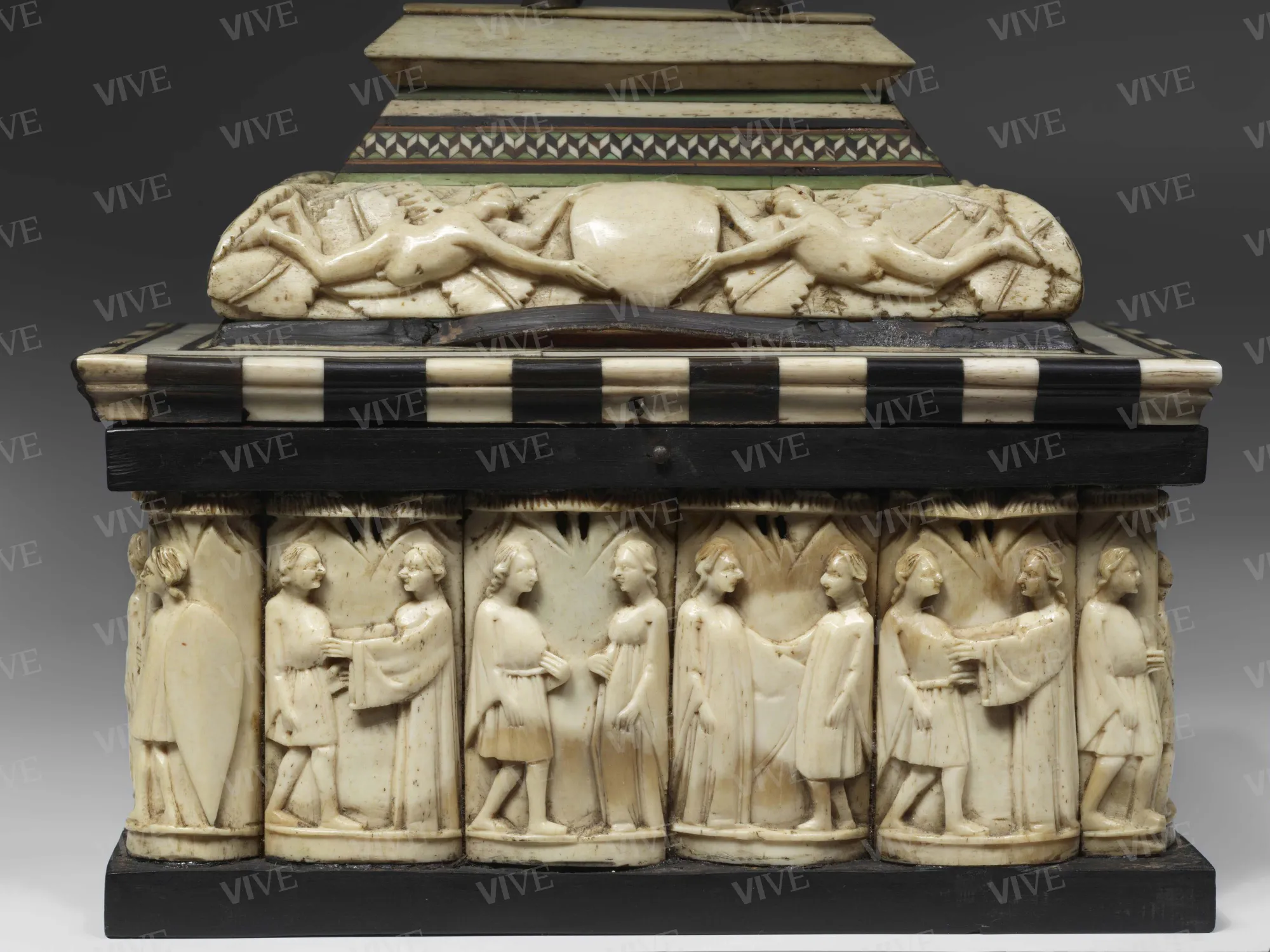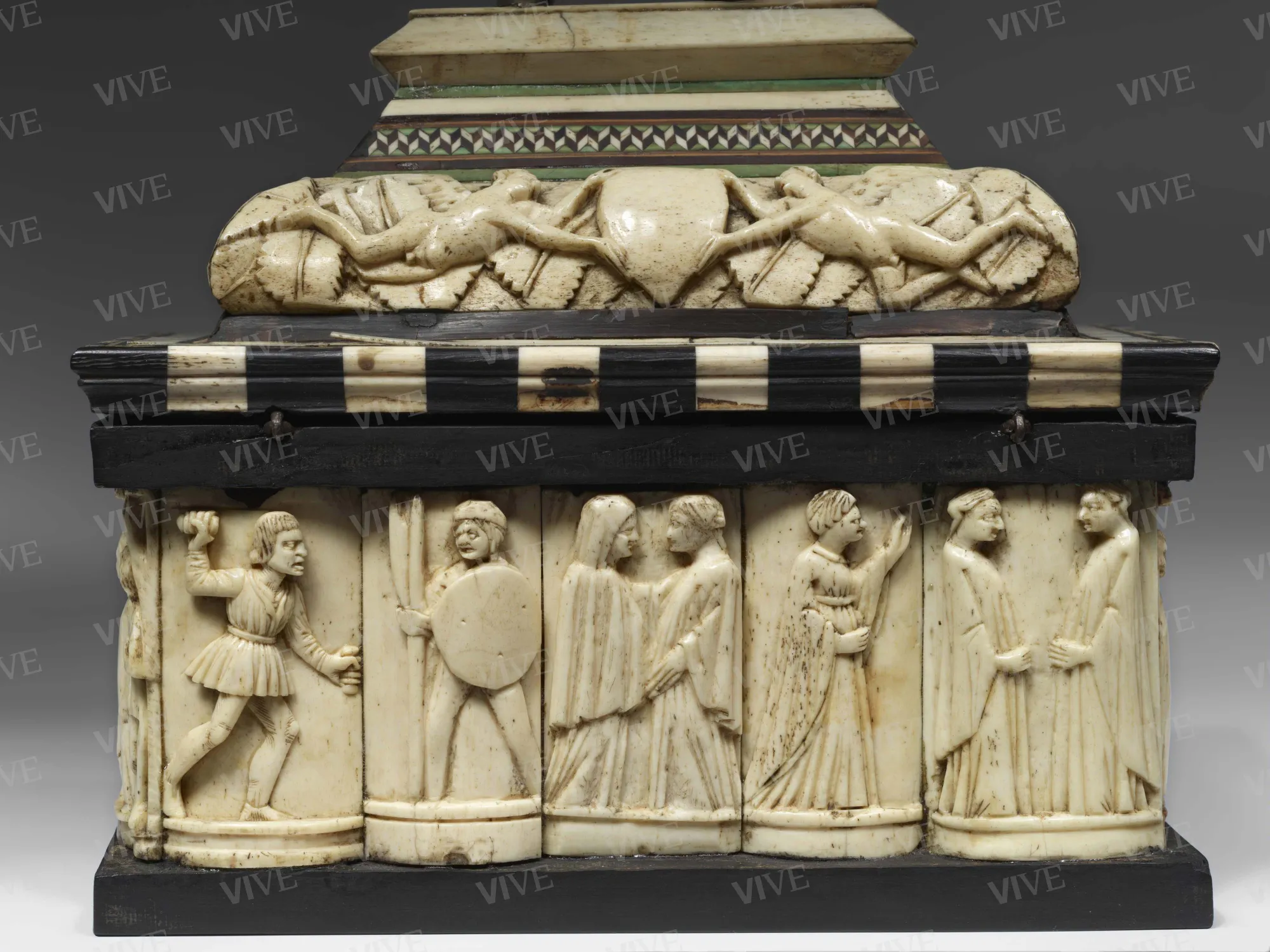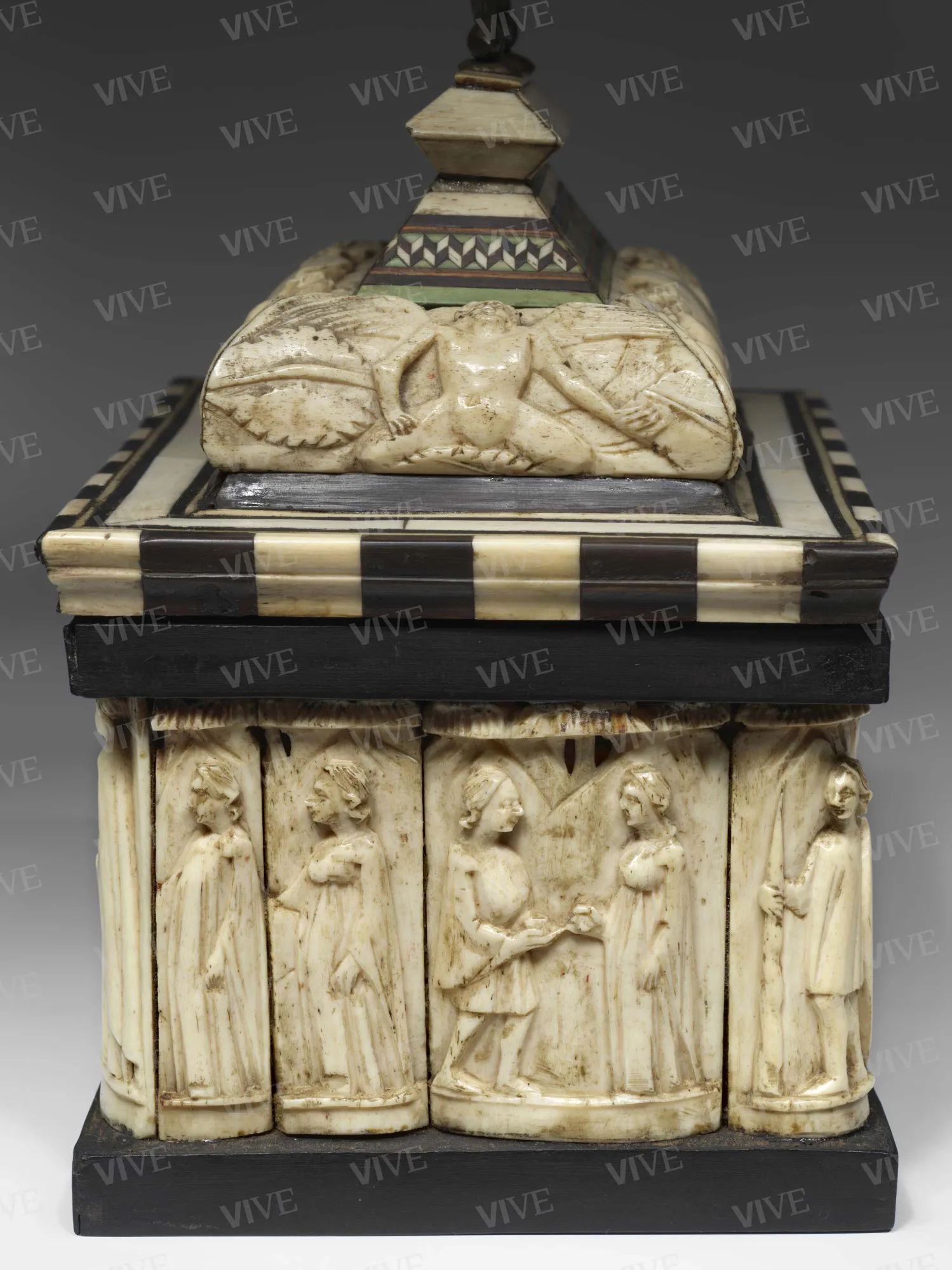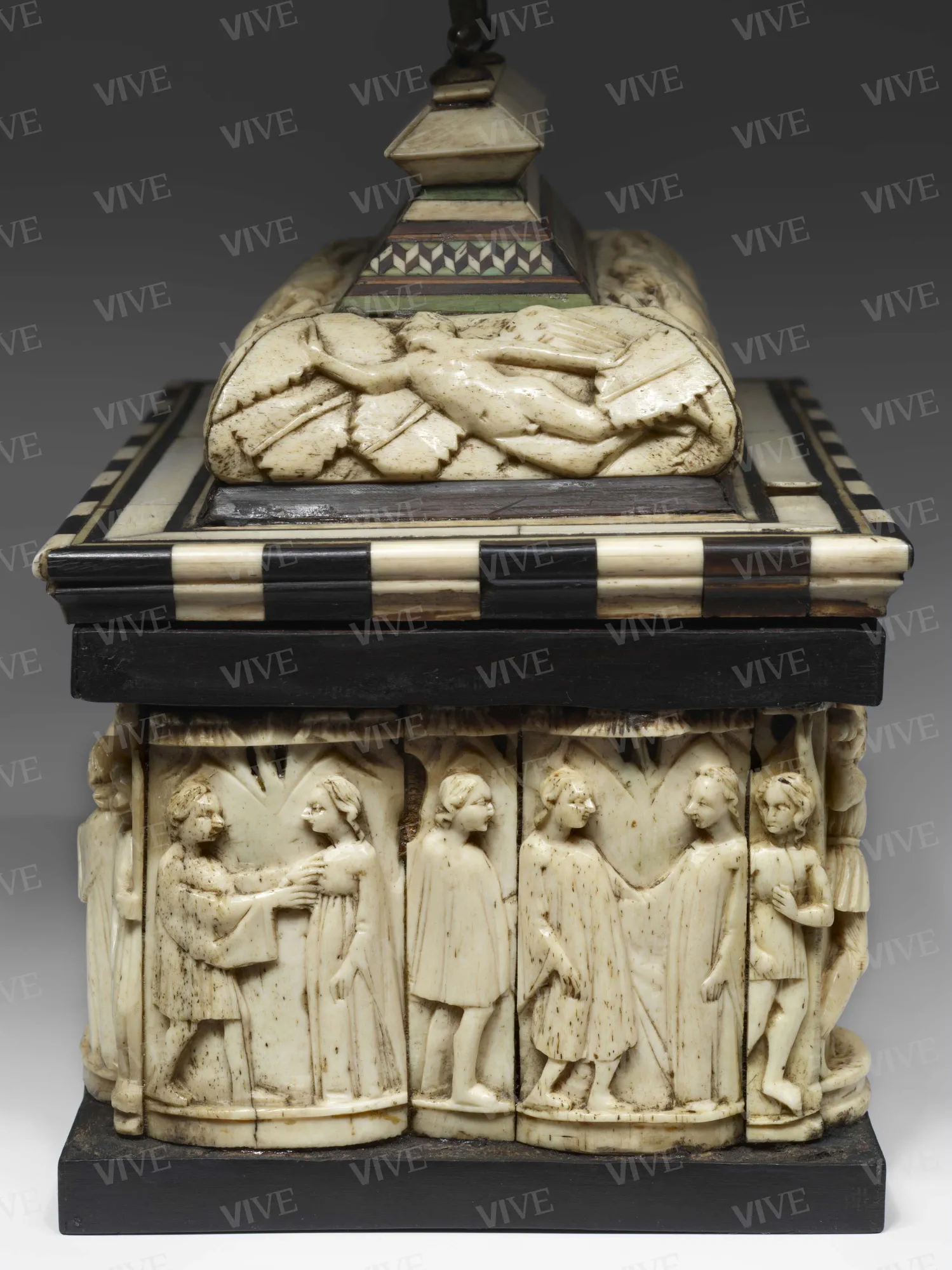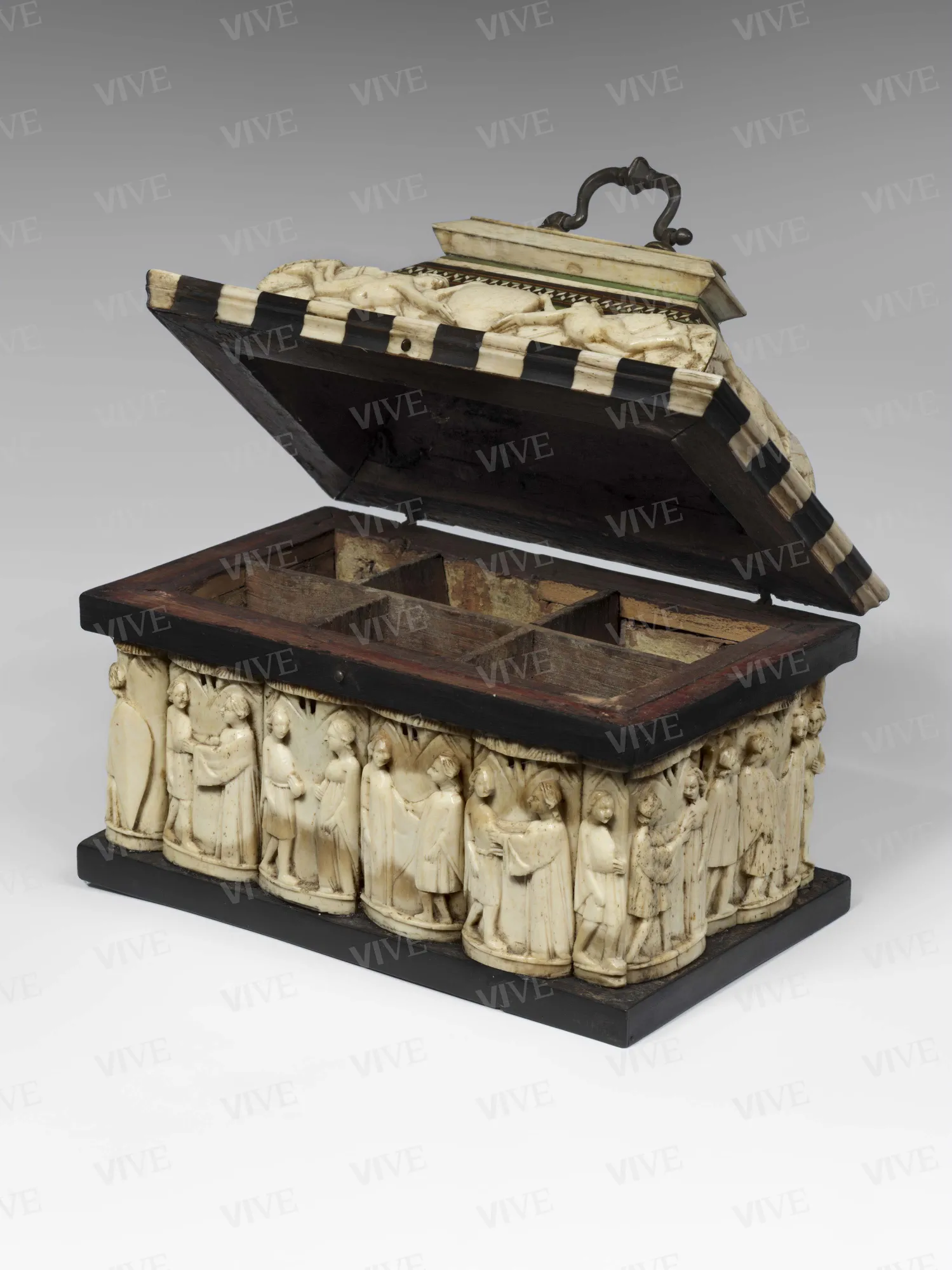Wedding casket
Embriachi workshop (?); northern Italian workshop; 19th-century restorer 1410–1430, and 19th century
The truncated-pyramid lid of this casket, resting on a two-colored frame and culminating in an elongated decahedron with a handle, has bone laths with nude winged putti holding shields on a rose-leaf background and Carthusian-style inlays. The case, bordered by black wooden elements, is covered with fifteen carved bone slats: twelve depict pairs of lovers; three, on the other hand, represent a man in the act of hurling objects, a figure with shield and halberd, and a woman in profile. The interior features a non-original wooden partition.
The truncated-pyramid lid of this casket, resting on a two-colored frame and culminating in an elongated decahedron with a handle, has bone laths with nude winged putti holding shields on a rose-leaf background and Carthusian-style inlays. The case, bordered by black wooden elements, is covered with fifteen carved bone slats: twelve depict pairs of lovers; three, on the other hand, represent a man in the act of hurling objects, a figure with shield and halberd, and a woman in profile. The interior features a non-original wooden partition.
Details of work
Catalog entry
Elephant ivory, sometimes unavailable in the medieval West, was occasionally replaced with more readily available and less expensive materials such as the bones of other animals. As early as the third quarter of the fourteenth century in central and northern Italy, carved bone lamellae, fixed on a wooden base and juxtaposed to obtain figurative cycles, were used to make valuable artifacts. This procedure became a staple in the workshop that was founded and promoted by the Florentine merchant Baldassarre Ubriachi or Embriachi, first in Florence and then in Venice. The workshop, directed by the Florentine carver Giovanni di Jacopo, produced both ambitious furnishings such as altarpieces and large chests, and small objects such as altar elements, mirror frames, and, above all, caskets and chests. The fluctuations in the quality of the artifacts that—following a very popular scholarly piece by Julius von Schlosser—are generally referred to as Embriachesque are due to the existence of several workshops that, while reproducing older prototypes, specialized in a more serial production (Schlosser 1899; Merlini 1989; Tomasi 2016a; Chiesi 2018). The Palazzo Venezia casket is one of the most typical examples of this type of production, and its bone applications are from different phases of the activity of the workshops operating in the aftermath of Baldassarre’s workshop. The casket, in fact, at some unspecified date, had to be repaired, which resulted in the integration of five elements from different periods, a common enough practice in nineteenth- and twentieth-century collecting. The original ten lamellae depict affectionate couples facing each other and dressed in tunics that are tight around the breast area with wide sleeves for the female figures and short skirt with wide sleeves for the male figures. The upper part of the plates is occupied by stylized trees partly worked in openwork that constitute an intermediate moment between the more articulated vegetation of the specimens from the workshop’s earliest activity and the sketched, uncarved openwork of later pieces. These features date from about the first decade of the fifteenth century in the context of the Embriachi workshop, even though they are clearly a more cursive type of production. These lamellae are similar to the twelve paired lamellae from the Museo Nazionale in Ravenna, which are datable to the early fifteenth century (Martini 1993a). Of the five reused plates, however, two with profile pairs are particularly interesting. Compared to the ten just discussed here, the upper part with the trees has been cropped and the execution is much sketchier, as can be seen if we compare it with a casket from the Duca di Martina museum in Naples (Giusti 1981). Two others bearing a soldier with shield and halberd and a woman in profile can be related to the experiences of the so-called “first group of Susanna stories” (Merlini 1989, p. 276), excellent examples of which are a casket from Modena (Merlini 1989, p. 272, fig. 12) and one from Ravenna, where there is a halberdier that is to all extents and purposes identical to the one on the casket under consideration here (Martini 1993b). The fifth plaque, on the other hand, which depicts the stonecutter of the two elders from the Old Testament episode of Susanna, belongs to the so-called “second workshop of the Susanna stories”—considering the powerful build, squared jaw, aquiline nose, and a pronounced convexity of the relief—and can be dated to around the second or third quarter of the fifteenth century (Merlini 1989, pp. 276–277). There are possible convergences with a mirror fragment depicting the god of love in the Museo Civico in Turin (Tomasi 2016).
Giampaolo Distefano
Entry published on 12 February 2025
State of conservation
Good.
Provenance
Rome, Tower Wurts collection, 1933.
References
von Schlosser Julius, Die Werkstatt der Embriachi in Venedig, in «Jahrbuch der Kunsthistorischen Sammlungen des Allerhöchsten Kaiserhauses», 20, 1899, pp. 220-282;
Hermanin Federico, Il Palazzo di Venezia, Roma 1948, pp. 292-293;
Giusti Paola, in Giusti Paola, Leone de Castris Pierluigi (a cura di), Medioevo e produzione artistica di serie: smalti di Limoges e avori gotici in Campania, catalogo della mostra (Napoli, Museo Duca di Martina, ottobre 1981-aprile 1982), Firenze 1981, pp. 130-131, n. II, 18;
Merlini Elena, La “Bottega degli Embriachi” e i cofanetti eburnei fra Trecento e Quattrocento: una proposta di classificazione, in «Arte cristiana», 76, 1989, pp. 267-282;
Martini Luciana, in Martini Luciana (a cura di), Oggetti in avorio e osso nel Museo Nazionale di Ravenna. Sec. XV-XIX, Ravenna 1993, pp. 75-77, nn. 34-35 (Martini 1993a);
Martini Luciana, in Martini Luciana (a cura di), Oggetti in avorio e osso nel Museo Nazionale di Ravenna. Sec. XV-XIX, Ravenna 1993, pp. 95-98, n. 136 (Martini 1993b);
Tomasi Michele, Miti antichi e riti nuziali: sull’iconografia e la funzione dei cofanetti degli Embriachi, in «Iconographica», 2, 2003, pp. 126-145;
Tomasi Michele, La bottega degli Embriachi e gli oggetti in legno e osso in Italia fra Tre e Quattrocento, in Castronovo Simonetta, Crivello Fabrizio, Tomasi Michele (a cura di), Avori medievali. Collezioni del Museo Civico d’Arte Antica di Torino, Savigliano 2016, pp. 151-153 (Tomasi 2016a);
Tomasi Michele, in Castronovo Simonetta, Crivello Fabrizio, Tomasi Michele (a cura di), Avori medievali. Collezioni del Museo Civico d’Arte Antica di Torino, a cura di, Savigliano 2016, pp. 206-207, n. 52 (Tomasi 2016b);
Levi Donata, Beautiful Houses. Spazi e arredi tra mercato e collezionismo, in Pellegrini Emanuele (a cura di), Voglia d’Italia. Il collezionismo internazionale nella Roma del Vittoriano, catalogo della mostra (Roma, Palazzo Venezia; Gallerie Sacconi al Vittoriano, 7 dicembre 2017-4 marzo 2018), Napoli 2017, pp. 81-97;
Chiesi Benedetta, Gli Embriachi e le botteghe dell’Italia settentrionale fra Tre e Quattrocento, in Ciseri Ilaria (a cura di), Gli avori del Museo Nazionale del Bargello, Milano 2018, pp. 334-335.

